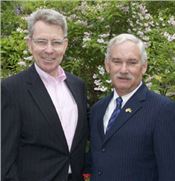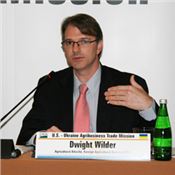|
Trade Abroad

Pictured on the left is Geoffrey Pyatt, U.S. Ambassador to Ukraine visiting with
USDA Acting Deputy Secretary Michael Scuse at the Chief of Mission’s Residence in Kyiv, Ukraine.
Photo by John LaRose
Ukraine Is Stretched Rubber Band, Eager to Launch Production
3rd of a 10 Part Series
JOHN M. LAROSE
BETTY VALLE GEGG-NAEGER
MidAmerica Farmer Grower
KYIV, UKRAINE
Market conditions and the business environment in the Ukraine were topics at a briefing given to the USDA led Trade Mission to Ukraine recently. Led by USDA Acting Deputy Secretary (ADS) Michael Scuse the group included five State Departments of Agriculture and eight U.S. agricultural organizations and agribusinesses.
The briefing was presented by Geoffrey Pyatt, U.S. Ambassador to Ukraine, Michelle Smith, Commercial Officer, U.S. Embassy and Dwight Wilder, Agriculture Attaché, Foreign Agriculture Service (FAS), Kyiv.
In an introduction to the program, ADS Scuse stated it’s important that the delegation get a better understanding of the business and investment opportunities available in Ukraine. “We have had a relationship with Ukraine the last few years,” he said, offering his thanks to the U.S. business delegation that was present. “There is a tremendous opportunity and potential here for us, not only in trade, but there are investment opportunities that many companies are looking for in this part of the world.”
Ambassador Pyatt said, “This mission is occurring at the best time of year to see the Ukrainian countryside which is known as the breadbasket of Europe. The extraordinary fertility of this country, this country’s favorable geography is a wonder to see,” he began. “It is a country which sits at the crossroads of Europe and Eurasia, with some of the best agricultural land anywhere on the Eurasian landmass.”
“Ukraine has enormous, enormous potential. When I talk to some of our big agri-industry companies, they make the point that if they could get North American levels of productivity here, they would be able to boost output by another 50 percent in what is already a very big agricultural country. Ukraine is, among other things, the world’s number one exporter of sunflower oil, and you don’t get to be the number one exporter of sunflower oil without growing a lot of sunflowers. A beautiful sight is the sunflowers as far as the horizon on the flat, rolling plains when the sunflowers are in bloom.”
Ambassador Pyatt has been working very closely with the government that has gone through an extraordinary process of adjustment the past two and a half years since the revolution brought this government to power. “The Ukrainians have been engaged in a concerted effort to defend their territory against Russian aggression. Russia has taken Crimea and also has occupied a little chunk of Southeastern Ukraine. Among the companies affected by that was Cargill which abandoned a large processing facility in the area that is now under occupation.”
“However, the country is largely moving on. This is a country bordered by four European Union (EU) member states, and it’s deeply European. It is a country that was very much at the crossroads of different European kingdoms and cultural trends, and then was hived off during Soviet times. In its first 20 years of the country’s history, it tried to be a bridge between Europe and Russia/Eurasia, but today a substantial majority of Ukrainians want to be a full member of the European community with EU membership”
“Ukraine has signed an association agreement with the EU which gives them duty-free access to the European market,” Ambassador Pyatt said. “This is beginning to ripple across Ukrainian agriculture and the Ukrainian economy, but it’s really just beginning, in part because of the dislocation that has accompanied the confrontation with Russia. Ukraine had been doing about half of its trade with Russia, but now that’s gone away.”
“This is a country that has been invaded pretty much by everyone: Ottomans, Swedes, Nazis, and the Soviets. It’s also a country that, if they can get their infrastructure policies right, will have good river transport, a rail network that is waiting to be exploited, has easy maritime access to food deficit regions in North Africa and the middle East in particular, and is poised to be an important partner with the United States, as agriculture tries to feed a world where food demand is soaring. Ukraine will be an important part of that.”
“Ukraine is going through a radical process of constitutional reform. It wants its government to be accountable to the people. Much like the United States, which was a country forged in revolution, Ukraine is going through a similar process, trying to build more accountable institutions,” stated Ambassador Pyatt.

Michelle Smith, Commercial Officer, U.S. Embassy
Michelle Smith, said her focus is on bringing equipment exporters of agricultural as well as food processing machinery to Ukraine. She detailed why companies in the United States should be exploring trade with Ukraine, and why now. “Some people are surprised to know that Ukraine is the largest country wholly in Europe,” Smith said. “It is similar geographically to the size of Texas, and in terms of population, has the combined populations of California and Washington State. However, people I meet often hesitate to come here because they think there is a lot of conflict in the streets. Actually, the military conflict right now only affects 3 percent of Ukraine’s territory. It’s far from Kyiv and people.”
“That shouldn’t stop people from coming to Ukraine and looking at the possibilities,” she said. “Agriculture is one of the four pillars on which this economy stands. It has 25 percent of the world’s black earth, and it was considered during Soviet times and still today, the breadbasket of Europe, of the former Soviet Union and the world. In Soviet times, agricultural production in Ukraine accounted for 25 percent of all agricultural output of the former Soviet Union. It was a powerhouse during those times.”
Today, agricultural output accounts for 14 percent of GDP in Ukraine which is only a fraction of its potential. Ukraine’s largest exporting partner was Russia, but now includes the EU, China and Turkey.
“We’re interested in agricultural equipment imports to help improve productivity of these fields,” Smith stated. “While overall agricultural machinery imports to Ukraine decreased in 2015, at the same time, the import of used agricultural machinery has increased, and I believe that if you have companies in the states that would be interested in opportunities, now is the time. The European Union agricultural equipment manufacturers are all over Ukraine, and they’re here in a big way. They’re coming with financing packages; the ironic thing is that the machinery the Europeans are selling are not as suitable to production here as U.S. equipment. So I would encourage you to let your state know that this is the biggest country in Europe, it’s the biggest market opportunity, and that market is being seized by European equipment manufacturers right now, even though U.S. companies have a foothold here. U.S. agricultural equipment producers account for 10 percent of the market. Germany has 50 percent of that but there is market share available here. There are definitely risks. When I counsel people, I say this is the land of both reward and risk. I think one of the largest is over regulation, however the government last year took significant steps to curb that.”
“Another factor is land reform. Currently there is a moratorium on the sale of agricultural land, but most U.S. companies say they don’t need to purchase land, all they want is a long-term lease. However, holding that up is there’s no unified electronic public register of lands right now. That’s partially because the government owns most of the land and this land is not in the register.”
“Anyone interested in this market, whether for tillage or food processing equipment should bring financing options with them, because that’s what the Europeans are doing.” Smith added that the sale of irrigation equipment could be one of the best prospects in this country.
“In Southern Ukraine there is this amazing system of canals that have dried up, and there are companies already here as we speak from India and elsewhere trying to exploit the opportunities,” she said. “They think it’s a gold mine. This is an area we don’t see the Europeans seeking, so American irrigation technology could be brought to bear.”

Dwight Wilder, Agriculture Attache, Foreign Agriculture Service (FAS) Kyiv.
Dwight Wilder discussed the market for seeds and other processed products in Ukraine. “I think as you move up the value chain, there are little nuggets of gold to be found in things like seed inputs,” Wilder said. “They import, the majority of their sunflower planting seeds right now. In fact, in 2015 Ukraine imported $32 million worth of sunflower planting seeds from the U.S. which was 28 percent of the market for sunflower seeds. That’s 34 percent of Ukraine’s total inputs from the United States. Moving up the value chain, there’s a market for ingredient-type products like corn gluten, meal or certain types of isolated dairy protein products that are not produced in Ukraine but are very valuable in manufacturing animal feeds, nutrient supplements, energy drinks and things like that.”
Consumer oriented products like sauces for beef and seafood, dried vegetable mixtures or even high value pet foods could be in demand.
“There is a very wealthy segment of the Ukrainian society that has taste for very high value products, and I think that will only grow in the future and we could find niche markets for those things,” he said. “We are also the top exporter of almonds to Ukraine. We exported about $5 million worth in 2015, and that was 94 percent of the market here. One especially exciting import area is U.S. distilled spirits. That market grew by 850 percent over the past decade.”
“There is certainly a place on the table for Kentucky bourbon,” Wilder noted. “There are export opportunities for things like tobacco, tree nuts, livestock genetics, all of which are nuggets of gold for those who are willing to find them.
“Ukraine is a rubber band stretched back ready to let go in terms of Ag productivity and they will export that. So I see that as a good thing, even though we might think it’s competing with our products. We all know over the next 20-50 years the world will need all the food that can be produced.”
Ukrainians do have, higher-level education, for agricultural production and sciences. However, agriculture professionals in Ukraine note that there is room for improvement. Additionally, they recognize that it is increasingly difficult to entice professionals, who have been trained in Ukraine’s urban centers, to live and raise families in underserved rural areas. ∆
JOHN M. LAROSE: Publisher MidAmerica Farmer Grower
BETTY VALLE GEGG-NAEGER: Senior Staff Writer, MidAmerica Farmer Grower
Editor’s Note: Watch for future articles about the agriculture industry of Ukraine and Romania. Next week: American Beef Could Find Niche Market In Ukraine.
Placement Of Ukraine In World Food Market (2015)Number 1 exporter of sunflower oil
Number 2 exporter of all grains
Number 2 exporter of nuts
Number 3 exporter of corn
Number 4 exporter of barley
Number 6 exporter of wheat
Number 1 producer of sunflower, sunflower oil
Number 3 producer of barley oil
Number 4 producer of nut Production
Number 5 producer of corn
Number 5 in world honey production.
Number 9 producer of wheat
Sources: Statistical Office of Ukraine.
Ukranian Data Collected By USDA Foreign Agriculture Service
• The country is similar to the wheat-producing regions of Canada and is characterized by abundant precipitation and cloudy skies.
• The winters are generally cold (similar to Midwestern States of the U.S. Annual precipitation also varies, from an average of 59 inches in the Carpathians to 12 inches on the Black and Azov Sea coasts.
• Currently agriculture accounts for around 16 percent of Ukrainian GDP, bringing about 17 billion U.S. dollars in export revenues. Moreover, around 30 percent of Ukraine’s total exports are agricultural exports.
• The share of soft commodities, primarily grain, oilseeds and vegetable oil, has been on an upward trend since 2010 reaching around 30 percent in 2014 of all exports from the country, stressing Ukraine’s status as one of the world’s largest producers and exporters of agricultural commodities.
• The country is richly endowed with chernozem (or black soil), one of the most fertile soils. With 41.5 million hectares of agricultural land (around 70 percent of the country’s total land mass). Ukraine accounts for about 25 percent of the global black soil area.
• U.S. accounts for a relatively small share of Ukraine’s exports and imports but its role could increase in the future. In 2014 Ukraine’s exports to the United States accounted for 1.2 percent of Ukraine’s overall exports. At the same time, US exports to Ukraine amounted to 3.6 percent of its overall imports. Trade between Ukraine and the United States experienced significant growth in 2000-2008. From 2013-2015 both exports and imports have declined, which coincided with the overall economic downturn in Ukraine. However, it is expected that in 2016-2020 trade between the two countries will resume growth.
• Agriculture employment in 2014 accounted for 17.1 percent of total employment.
• Ukraine is a major net exporter of corn, wheat, sunflower oil, barley, soybean, rapeseed, meat and by-products.
• Because Ukraine possesses 30 percent of the world’s richest black soil, its agricultural industry has a huge potential. However, farmland remains the only major asset in Ukraine that is not completely privatized. After collapse of the collective farms in the early 1990s, each individual member of the collective farm received his/her own share (plot) of land that they now own. They were allowed to rent it (up to 49 years) but not sell it. Therefore, currently the main method of land redistribution is rent.
• Ukraine’s major export markets are the EU, Asia, Africa, CIS and Middle East. ∆
|
|